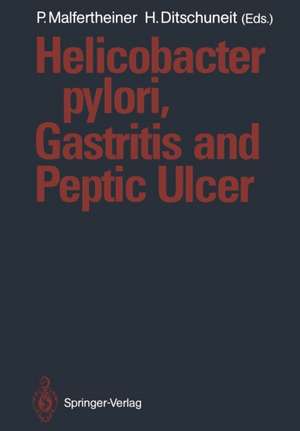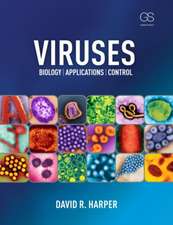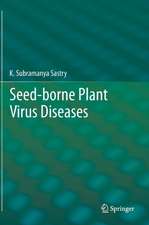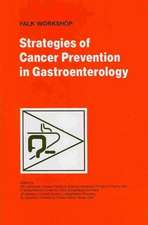Helicobacter pylori, Gastritis and Peptic Ulcer
Editat de Peter Malfertheiner, Hans Ditschuneiten Limba Engleză Paperback – 29 dec 2011
Preț: 730.34 lei
Preț vechi: 768.78 lei
-5% Nou
Puncte Express: 1096
Preț estimativ în valută:
139.75€ • 145.91$ • 115.66£
139.75€ • 145.91$ • 115.66£
Carte tipărită la comandă
Livrare economică 05-19 aprilie
Preluare comenzi: 021 569.72.76
Specificații
ISBN-13: 9783642753176
ISBN-10: 3642753175
Pagini: 496
Ilustrații: XV, 478 p.
Dimensiuni: 170 x 242 x 26 mm
Greutate: 0.78 kg
Ediția:Softcover reprint of the original 1st ed. 1990
Editura: Springer Berlin, Heidelberg
Colecția Springer
Locul publicării:Berlin, Heidelberg, Germany
ISBN-10: 3642753175
Pagini: 496
Ilustrații: XV, 478 p.
Dimensiuni: 170 x 242 x 26 mm
Greutate: 0.78 kg
Ediția:Softcover reprint of the original 1st ed. 1990
Editura: Springer Berlin, Heidelberg
Colecția Springer
Locul publicării:Berlin, Heidelberg, Germany
Public țintă
ResearchCuprins
Helicobacter pylori — Taxonomy and Biology.- Taxonomy of Helicobacter pylori and Related Bacteria.- Helicobacter pylori: Microbiological Aspects.- Development of Genetic and Molecular Approaches for the Diagnosis and Study of the Pathogenesis of Helicobacter pylori.- Assessment of DNA and Protein Molecular Fingerprinting Methods for Strain Identification of Helicobacter pylori.- The Genesis of Coccal Forms of Helicobacter pylori.- Epidemiology of Helicobacter pylori Infections.- Physiology of Helicobacter pylori.- In Vitro Susceptibility of Helicobacter pylorito Antibiotics and Bismuth Salts and the Importance of Aquired Resistance to Antibiotics in Treatment Failures of H. pylori Infection.- Taxonomy and Biology of Helicobacter pylori—a Comment.- Pathogenic Mechanisms of Helicobacter pylori.- Virulence Factors of Helicobacter pylori — Ultrastructural Features.- Molecular Cloning and Sequencing of Helicobacter pylori Urease Genes and Detection of H. pylori using the Polymerase Chain Reaction Technique.- The Structure of Helicobacter pylori Urease.- Pathogenic Mechanisms of Helicobacter pylori: Production of Cytotoxin.- Helicobacter pylori Hemagglutinins — Possible Gut Mucosa Adhesins.- Lectin Typing of Helicobacter pylori.- Association of Helicobacter pylori with Epithelial Cells.- Influence of Helicobacter pylori on Intragastric Environment: Bile Acids and Biliary Lipids.- Animal Models of Helicobacter pylori Gastritis.- The Pathogenic Mechanisms of Helicobacter pylori — a Comment.- Local and Systemic Immune Response.- Methods of Studying the Immune Response.- Serodiagnosis of Helicobacter pyloriInfections: Suitability of Various Antigen Preparations.- Possible Clinical Uses of Serology to Helicobacter pylori.- Evaluation of a Clinical Role for Serology toHelicobacter pylori.- Serum Antibodies to the Vacuolating Toxin Produced by Helicobacter pylori.- Local Immune Responses to Helicobacter pylori Infections.- Molecular Cloning of Immunodominant Antigen Epitopes of Helicobacter pylori for Development of a Specific ELISA to Diagnose H. pylori Infection.- The Effect of Treatment on Circulating Anti-Helicobacter pylori Antibodies — a Two-Year Follow-Up Study.- Local and Systemic Immune Response — a Comment.- Morphological Aspects of Gastritis.- Helicobacter pylori Induced Gastritis in Childhood.- Comparison of Several Methods of Detecting Helicobacter pylori.- Endoscopic and Histologic Aspects of Gastritis.- Correlation Between the Grade of Activity of Type B Gastritis and Synthesis of Glycoproteins.- Immunohistological Patterns of the Local Immune Response in Helicobacter pylori Gastritis.- Risk of Peptic Ulcer in Gastritis.- Differences Between Helicobacter pylori Associated Gastritis in Patients with Duodenal Ulcer, Pyloric Ulcer, Other Gastric Ulcer, and Gastritis Without Ulcer.- Lymphocytic Gastritis.- Exocrine and Endocrine Epithelial Changes in Types A and B Chronic Gastritis.- The Classification of Gastritis.- Morphological Aspects of Gastritis — a Comment.- Helicobacter pylori in Duodenal Ulcer Pathogenesis.- Aetiological Factors in Duodenal Ulcer.- The Histogenesis of Gastric Metaplasia, in Non-specific Duodenitis.- Gastric Metaplasia in Duodenal Mucosa — Key Factor for H. pylori Colonization and Duodenal Ulcer Pathogenesis?.- The Relationship between Gastric Metaplasia and Inflammation in the Duodenum.- Gastroduodenal Motility in Relationship with Peptic Ulcer Pathogenesis and Helicobacter pylori Infection.- Relationship Between Helicobacter pylori and Gastroduodenal Physiology: Acid Secretion andepsinogens.- Helicobacter pylori and Duodenal Ulcer in the Gastrin Link.- Early Relapse Rate After Healing of H. pyloriPositive Duodenal Ulcers.- Gastric Surgery and Helicobacter pylori.- Is H. pylori-Negative Duodenal Ulcer a Separate Disease?.- Helicobacter pylori in the Pathogenesis of Peptic Ulcer — Evidence in Favour.- Helicobacter pylori as a Pathogenetic Factor in Peptic Ulcer —the Argument Against.- Helicobacter pylori in Duodenal Ulcer Pathogenesis— a Comment.- Nonulcer Dyspepsia and Motility.- Is Helicobacter pylori a Cause of Nonulcer Dyspepsia?.- Gastritis and Altered Motility; the Ability of a Mucosal Inflammatory Reaction to Alter Enteric Nerve and Smooth Muscle in the Gut.- Influence of Chronic Antral and Duodenal Inflammation on Motor Disorders.- Therapeutic Approaches.- Why Should We Treat Helicobacter pylori Infection?.- How to Eradicate Helicobacter pylori and Prevent Reinfection.- Drug Resistance in Helicobacter pylori.- If, When, and How to Treat Children?.- The General Chemistry of Bismuth with Relevance to Pharmacy and Medicine.- Safety Profile of Bismuth-Containing Medications.- Is Nonulcer Dyspepsia Improved by Treating Helicobacter pylori Infection?.- Five-Day Triple Therapy and 15-Day Double Therapy on Helicobacter pylori Eradication.- Antibacterial Therapy: Effect on Healing and Relapse of Peptic Ulcer Disease.- Natural History and Long-Term Monitoring of Therapeutic Attempts to Eradicate H. pylori.- Optimal Conditions for the Design of a Clinical Trial in Helicobacter pylori Related Duodenal Ulcération.- Treatment of Helicobacter pylori infection: a Comment.- Perspectives.- Helicobacter pylori — Future Directions in Research.





